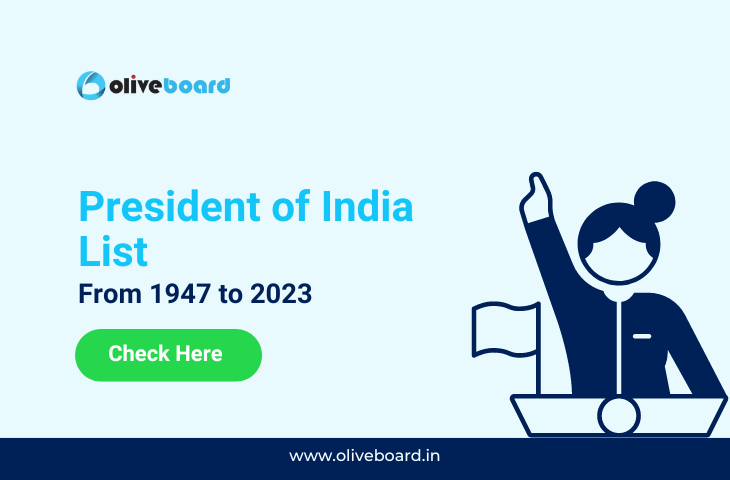The President is the head of the Indian State. He is the first citizen of India and acts as the symbol of unity, integrity, and solidarity of the nation.
The office of the President is created by Article 52 in Part V of the constitution.
The President is the formal head of the executive, legislature, and judiciary of India and is also the commander-in-chief of the Indian Armed Forces.
The President must be a citizen of India, older than 35 years of age, and qualified for election as a member of the Lok Sabha. The President’s term of office is five years, and he is eligible for re-election. His removal from office must be in accordance with the procedure prescribed in Article 61 of the Constitution. He may, by writing under his hand addressed to the Vice-President, resign from his office.
President of India List From 1947 to 2023
| S. No | President of India List | Time Period |
| 01 | Rajendra Prasad | 26 Jan 1950 – 13 May 1962 |
| 02 | Sarvepalli Radhakrishnan | 13 May 1962 – 13 May 1967 |
| 03 | Zakir Hussain | 13 May 1967 – 3 May 1969 |
| 04 | V. V. Giri ( Acting ) | 3 May 1969 – 20 July 1969 |
| 05 | Muhammad Hidayatullah ( Acting ) | 20 July 1969 – 24 Aug 1969 |
| 06 | V. V. Giri | 24 Aug 1969 – 24 Aug 1974 |
| 07 | Fakhruddin Ali Ahmed | 24 Aug 1974 – 11 Feb 1977 |
| 08 | B.D. Jatti ( Acting ) | 11 Feb 1977 – 25 July 1977 |
| 09 | Neelam Sanjiva Reddy | 25 July 1977 – 25 July 1982 |
| 10 | Giani Zail Singh | 25 July 1982 – 25 July 1987 |
| 11 | Ramaswamy Venkataraman | 25 July 1987 – 25 July 1992 |
| 12 | Shankar Dayal Sharma | 25 July 1992 – 25 July 1997 |
| 13 | K. R. Narayanan | 25 July 1997 – 25 July 2002 |
| 14 | A.P.J Abdul Kalam | 25 July 2002 – 25 July 2007 |
| 15 | Pratibha Patil | 25 July 2007 – 25 July 2012 |
| 16 | Pranab Mukherjee | 25 July 2012 – 17 July 2017 |
| 17 | Ram Nath Kovind | 25 July 2017 – 25 July 2022 |
| 18 | Droupadi Murmu | 25 July 2022 – Present |
Powers and Functions of the President of India
The President of India is the head of the state by the power derived from Article 53. The functions performed and the powers given to the President can be categorized into the following :
- Executive Power
- Legislative Power
- Financial Power
- Judicial Power
- Diplomatic Power
- Military Power
- Emergency Power
- Ordinance Making Power
- Executive Power of President
- All executive actions of the Indian Government are formally taken in the President’s name.
- The President can make the rules to simplify the business transaction of the Central Government.
- The President appoints the following people :
- Prime Minister and council of ministers on the recommendation of the Prime minister
- Attorney General of India and also decides his remuneration
- Comptroller and Auditor General of India (CAG)
- Chief Election Commissioner and other Election Commissioners
- Chairman and members of Union Public Service Commission (UPSC)
- Governors of states
- Chairman and members of Finance Commission of India
- He appoints the National commission of :
- Schedule Caste (SC)
- Schedule Tribe (ST)
- Other Backward Class (OBC)
- The President also appoints the inter- state councils .
- The President can declare any area as a Scheduled area and he also has the power to respect the administration of Schedule area and tribal areas.
- The President can seek reports from the Prime minister on administrative matters.
- He directly administers the union territories through administrators appointed by him.
- Legislative Powers of President
- The President can summon the Parliament and can also dissolve the Lok Sabha.
- He addresses the Parliament’s First session after every General Election.
- He appoints the :
- Speaker and Deputy Speaker of Lok Sabha
- Chairman and Deputy Chairman of Rajya Sabha
- He also nominates :
- 2 Anglo-Indian members of Lok Sabha
- 12 members of Rajya Sabha
- Prior recommendation of the President is needed to introduce certain bills including money bill & finance bill.
- A bill passed by the parliament becomes an act only after the president has given assent to it. The President has veto power over the bills passed by the legislature.
- Financial Power of President
- Prior recommendation of the President is a must for introducing money bills.
- He causes the Union Budget to be laid before the Parliament.
- President recommendation is a prerequisite to make a demand for grants.
- The contingency fund of the Union government is held in the name of the President of India, who releases the funds on request of the Union Cabinet.
- The President constitutes the Finance Commission every 5 years.
- Judicial Power of President
- The President appoints Chief Justice, judges of the Supreme Court and High Court.
- Under Article 72, the President has the power to grant pardon, reprieve, respite or remission in the following conditions :
- Punishment is for an offence against Union law
- Punishment is by a military court
- A sentence that is of death
- He also has the power to suspend, remit or commute the sentence in such cases.
- Diplomatic Power of President
- International Treaties, and agreements approved by Parliament are negotiated and concluded in the President’s name.
- The President is the Representative of India in International Forums and Affairs.
- Military Power of President
- The President is the Commander of the Defence Forces of India.
- He appoints the chief of the Army, Navy and Airforce.
- He can declare war or conclude peace, with approval of the Parliament.
- Emergency Powers of President of India
The President of India has the power to deal with three types of Emergency given in the Indian Constitution :
- National Emergency under Article 352
- President’s Rule under Article 356 & 365
- Financial Emergency under Article 360
8. Ordinance Making Power of President
- Article 123 of Indian Constitution deals with Ordinance making power of the President.
- The President promulgates an ordinance to deal with unforeseen or urgent matters, on the recommendation of the union cabinet.
President of India Salary 2023
The salary of the President of India is Rs. 5 lakh/month (non-taxable). Apart from this, the President of India also gets several allowances in the form of accommodation, medical facilities, and security.
Sample Questions :
- The President can dismiss a member of the council of Ministers :
- With the consent of the speaker
- Only under emergency conditions
- On the recommendation of the Prime Minister
- Upon his own will
Answer: C – On the recommendation of the Prime Minister
2. The President of India is :
- The head of the ‘State’
- The head of the Government
- The head of the state and Government
- None of the above
Answer: A – The head of the ‘State’
3. Money bills can be introduced in the Lok Sabha with the prior permission of the :
- President
- Prime minister
- Speaker
- Cabinet
Answer: A – President
4. Who decides a ‘bill’ is a money bill?
- Prime minister
- Speaker of Lok Sabha
- Chairman of Rajya Sabha
- President
Answer: B – Speaker of Lok Sabha
5. The ministers in the Union Government hold office during the pleasure of the :
- Lok Sabha
- President
- Parliament
- Prime minister
Answer: B – President
Ebooks
You can download 200+ ebooks important for SSC, Banking, Railway, Insurance, and other government exams here.
Oliveboard Bolt series E-books:

